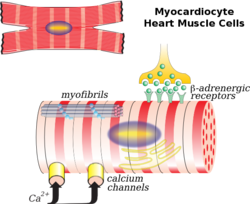Cardiomyocyte
| Cardiac muscle cells | |
|---|---|

Illustration of a myocardiocyte, including organelles and cell membrane functions
|
|
| Details | |
| Precursor | Mesoderm |
| System | Cardiovascular system |
| Identifiers | |
| Latin | cardiomyocytus; myocytus cardiacus |
| Code | TH H2.00.05.2.02004 |
|
Anatomical terminology
[]
|
|
Cardiac muscle cells or cardiomyocytes (also known as myocardiocytes or cardiac myocytes) are the muscle cells (myocytes) that make up the cardiac muscle (heart muscle). Each myocardial cell contains myofibrils, which are specialized organelles consisting of long chains of sarcomeres, the fundamental contractile units of muscle cells. Cardiomyocytes show striations similar to those on skeletal muscle cells. Unlike multinucleated skeletal cells, the majority of cardiomyocytes contain only one nucleus, although they may have as many as four. Cardiomyocytes have a high density, which allows them to produce adenosine triphosphate (ATP) quickly, making them highly resistant to fatigue.
There are two types of cells within the heart: the cardiomyocytes and the cardiac pacemaker cells. Cardiomyocytes make up the atria (the chambers in which blood enters the heart) and the ventricles (the chambers where blood is collected and pumped out of the heart). These cells must be able to shorten and lengthen their fibers and the fibers must be flexible enough to stretch. These functions are critical to the proper form during the beating of the heart.
Cardiac pacemaker cells carry the impulses that are responsible for the beating of the heart. They are distributed throughout the heart and are responsible for several functions. First, they are responsible for being able to spontaneously generate and send out electrical impulses. They also must be able to receive and respond to electrical impulses from the brain. Lastly, they must be able to transfer electrical impulses from cell to cell.
All of these cells are connected by cellular bridges. Porous junctions called intercalated discs form junctions between the cells. They permit sodium, potassium and calcium to easily diffuse from cell to cell. This makes it easier for depolarization and repolarization in the myocardium. Because of these junctions and bridges the heart muscle is able to act as a single coordinated unit.
Cardiomyocytes are about 100μm long and 10-25μm in diameter.
Humans are born with a set number of heart muscle cells, or cardiomyocytes, which increase in size as heart grows larger during childhood development. Recent evidence suggests that cardiomyocytes are actually slowly turned over as we age, but that less than 50% of the cardiomyocytes we are born with are replaced during a normal life span. The growth of individual cardiomyocytes not only occurs during normal heart development, it also occurs in response to extensive exercise (athletic heart syndrome), heart disease, or heart muscle injury such as after a myocardial infarction. A healthy adult cardiomyocyte has a cylindrical shape that is approximately 100μm long and 10-25μm in diameter. Cardiomyocyte hypertrophy occurs through sarcomerogenesis, the creation of new sarcomere units in the cell. During heart volume overload, cardiomyocytes grow through eccentric hypertrophy. The cardiomyocytes extend lengthwise but have the same diameter, resulting in ventricular dilation. During heart pressure overload, cardiomyocytes grow through concentric hypertrophy. The cardiomyocytes grow larger in diameter but have the same length, resulting in heart wall thickening.
...
Wikipedia
